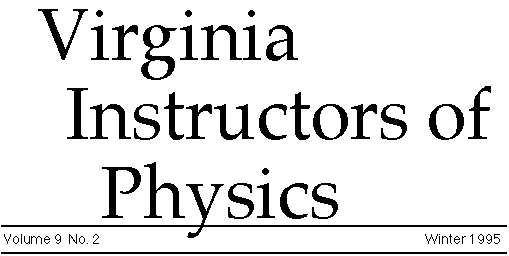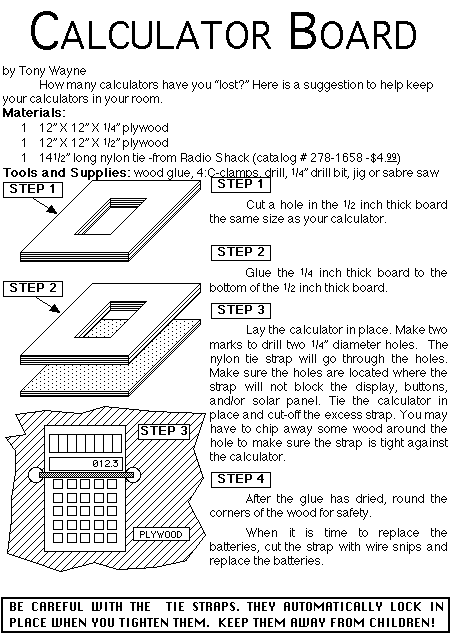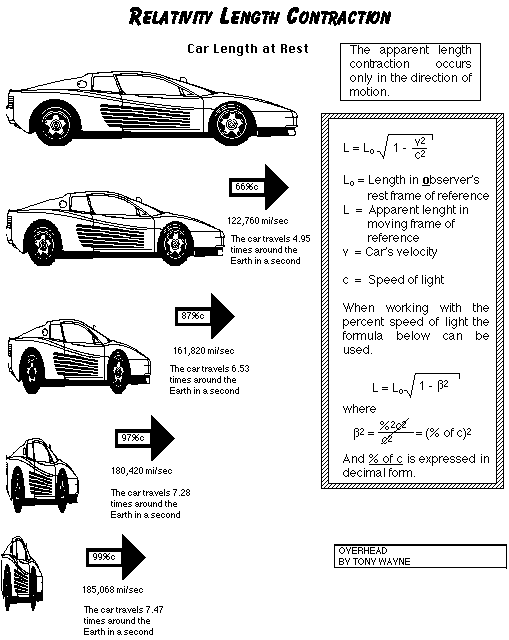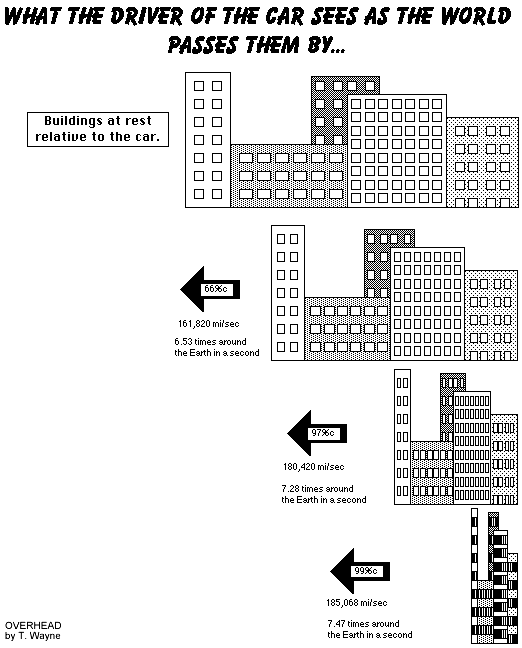|

In this issue:
Last Fall's Meeting
Calculator Board
Easy, Useful Way to Inventory Your Equipment
What Can You Do with a Balloon
Pioneer Offer?
Relativity Overheads
1,000,000 Points Equals an "A"
A New Cartesian Diver
The Classroom Photo Phone
Physics Resource List
Last Fall's Meeting
by Tony Wayne
First order of businees was the election of officers.
President: Tony Wayne
Vice-President: Andy Jackson
Special Activities Officer: Brion Patterson
Much discussion tookplace as pertaining to what to do with the
newsletter. The suggestion was made to include a physics resource
list and perhaps guest columns form manufacturers and teachers like
your self.
The rest of the morning was spent sharing teaching ideas.
After lunch Dr. Bob Kolvard, from The University of Arizona,
demonstrated of curriculum enhancement called H.I.P. physics.
Many thanks go out to Dr Deaver and the University of Virginia's
Physics Department for sponsoring not only the fall meeting but also
the cost of reproduction and mailing of this newsletter.

Easy, Useful Way to Inventory Your
Equipment
by Andy Jackson, Harrisonburg HS
What's the longest amount of time you have ever spent trying to find
a piece of equipment you knew you had? For me it is something like
weeks. It was somewhere but I couldn't put my finger on it. Or if
that is not a problem for you, maybe you are required to take an
inventory of your equipment each year and are looking for a way to do
it as easily as possible. This method is timeconsuming at first, but
after the initial set up it is no hassle and all reward.
First, label every column of storage space with a letter. Start at
one corner and work your way around the room (or rooms) and through
the alphabet. Then Each shelf in a column is numbered. I let the top
shelf be 1 and count down. Then comes the time consuming part of the
process.
Create a spread sheet with four columns. The first column is the
"Topic," the second column is the "Item," the third column is the
"Quantity," and the fourth is the "Location." A typical entry in the
spread sheet would look something like this,
Topic Item
Quantity Location
magnetism disk magnets 12 L-5
Newtons laws tablecloth & dishes 1 O-2
sound tuning forks 12 S-4
Once you have all of your inventory entered you can use the spread
sheet "SORT" command to arrange it in several different forms. The
two forms I find most useful are to sort it alphabetically by "Topic"
and alphabetically by "Location." A list of the items by topic is
helpful to find the item on the shelf and to decide what equipment
you wish to order. A list sorted by location is useful when taking an
end of the year inventory to make sure nothing has walked during the
year. I find that having a hard copy of the inventory sorted by
"Topic" allows me to find any piece of equipment at any time in a
matter of seconds.(That is provided I put it back the last time I
used it!)
What Can You Do with a Balloon?
Recently a mail list subscriber asked the following question:
I'm doing a demonstration show on Friday night, and I wanted to do
a series of demonstrations using balloons as the basis for each
one.
Example: Balloon in bell jar, pull vacuum, watch expand, or balloon
in liquid Nitrogen, etc.........
Does anyone out there have a demo that they think is really neat
using a balloon? I have about 10 or so already in mind, and would
love to see some novel ideas come through the network. Wouldn't make
a bad article, once I got them all collected, would it Roger?
Thanx again,
Thanx in advance,
David Maiullo
Below are the responses, (credit has been given whenever
possible):
How about the water balloon heat capacity demo? Fill a balloon
with water and hold a lit match or candle up to the surface of the
balloon. It will easily withstand the flame because of the high heat
capacity of the water. You can even hold it over your head while you
torch it if you want some drama. A candle or match works best since
it burns cooler than a butane lighter; you can use a lighter but it
will sometimes burn through after prolonged heating. Use a good
balloon and fill it pretty full so that the skin is stretched thin,
but if you get soaked I don't want to hear about it. Wouldn't mind
seeing it, though.
Brett
Balloon electroscope: Charge 2 balloons on opposite ends of a string
and hold the string in the middle. Charge a balloon and put on the
wall, podium, or whatever. You can also raise a little hair holding a
charged balloon over someone's head.
Frank Nilon
, Pomona College
Change of phase in CO2: Place a small pellet of dry ice in a small
test tube and cover the top with a balloon (deflated). Inflate the
balloon by warming it in you hands until the dry ice has sublimated.
Immerse the test tube in liquid nitrogen and dry ice will form on the
sides of the test tube and the balloon will deflate (and sometimes
get sucked into the small test tube.
Frank Nilon
, Pomona College
While you have the dry ice and the balloon:Put some in a balloon, tie
off the balloon and weigh it on a balance, watch the "weight" change
as the dry ice sublimes. When the balloon is fully inflated it can be
used as a sound lens (I usually use a weather balloon for this). The
effect is most striking if you use a fairly incoherent source of
sound (e.g. running water).
Cliff
I recall a demo where a balloon is quickly stretched across the mouth
of a flask containing a small amount of rapidly boiling water. The
flame is then removed, and as the flask cools, the balloon is sucked
entirely inside until it "coats" the inside of the flask. When
offered as a pre-made item, the balloon-coated flask is immensely
befuddling as to how it was created
William Beaty,
EE/Programmer/Science exhibit designer
Here's one from Daedalus in Britain: a cardboard box which is not
stable, and falls over, even though it is a perfect cube. In reality,
the box is brown paper stretched on a frame, and has a large helium
balloon in one side, so that it's center of gravity is shifted to
OUTSIDE the base of the box.
William Beaty
,
EE/Programmer/Science exhibit designer
Another: creating neutral density with carrots and duct tape. Tie a
stick of carrot (etc.) to a helium balloon, and bite it down until
the balloon just hangs in the air. If you bite too much, add weight
by sticking patches of duct tape to the balloon. A room full of these
is great fun. If you make a custom mylar bag, fill it with helium,
then cover it with duct tape until it's neutralized, you can play
catch with it and show that air has considerable mass even when
weightless.
William Beaty,
EE/Programmer/Science exhibit designer
Here's one that a friend found: balloon acoustic lens. A standard
balloon is under pressure and has a higher index of acoustic
refraction than the surrounding air, so it behaves as a sound lens.
Practice with a balloon and a microphone, and you'll soon be able to
listen in on distant conversations. Use a balloon and a tiny
loudspeaker, and you'll be able to project a sound beam to an
individual listener.
William Beaty
EE/Programmer/Science exhibit designer
How about sticking a long darning needle through a balloon without
busting it?
Ron Ebert
, UCR Physics Department
Or a 2 to 1 mixture of hydrogen and oxygen in the balloon,which has a
tube in the stem that has a wire connected to a small Tesla coil. The
Tesla coil is turned on by a remote foot switch -the best bang you
ever heard.)
Ron Ebert
, UCR Physics Department
Or tie a small weight to the end of the balloon and suspend the
balloon in an air jet, tilting the jet away from a vertical
angle.
Ron Ebert
, UCR Physics Department
Fill a balloon with helium and tie it to a weight. Put the balloon on
a cart and then place a large bell jar around the balloon. When you
shove the cart forward, the balloon moves forward, contrary to what
you would expect.
Ron Ebert
, UCR Physics Department
Another balloon demo is the helium balloon in helium. I do it with a
large glass battery jar. Blow up a helium balloon so that it's
buoyant in air, then put it inside the upside-down glass jar and let
it float to the top. Then squirt some helium into the jar until it
displaces the air. The helium balloon then sinks to the bottom as
it's no longer lighter than the "air" in the jar. If you pick the jar
up, the balloon will float at the bottom of the jar on the air/helium
interface. Tip the jar to let the helium escape and the balloon rises
back to the top of the jar.
Brett
If you don't have a large-enough glass jar, you can remove one side
of a cardboard box and replace it with a piece of acrylic or other
plastic sheet. Just make sure to seal all the edges with some duct
tape etc. so the helium won't leak too fast.
Brett
One more thing I do to explain the sound lens is use an oscilloscope
and microphone to measure the speed of sound through the CO2 filled
balloon. I then calculate the index of refraction and focal length
(at least for the higher frequencies).
Ron Ebert
, UCR Physics Department
Expanding universe demo - connect a balloon to an air supply. As you
slowly inflate it, paint dots on it in different colors. Every dot
moves away from every other dot, emulating the behavior of galaxies
in our universe.
Ron Ebert
, UCR Physics Department
And the opposite, while not exactly a physics demo, is also fun:
Totally inflate a small balloon, then write on it in ink, in the
smallest writing you can manage. When deflated, the writing becomes
unreadably small. Kids can then inflate them and see what they
say.
William Beaty
EE/Programmer/Science exhibit designer
For this demonstration you need two identical balloons (about 12 inch
maximum diameter models), a plastic tube a few inches long of
diameter such that the balloons can be blown up and connected over
the end of the tube, and a wire hose clamp. Connect one balloon to
one end of the tube, blow it up to about three inches in diameter and
clamp it so no air can flow out of the balloon. Blow up the second
balloon to about six inches in diameter and slip it onto the other
end of the tube. No air can flow between the balloons because of the
hose clamp.
What will happen when the clamp is removed:
(a) Will the smaller balloon become smaller and the larger balloon
larger?
(b) Will they become equal in size?
(c) Will they stay the way they are?
Let the group vote, then perform the experiment with the smaller
balloon on top. Suggest that the reason for the resulting effect is
that when the clamp is removed gravity pulls the air downward. After
the boos and hisses subside, tell them the real reason, if you can
think of one.
(The smaller balloon will inflate the larger balloon. The molecules
of the smaller balloon pulling harder than the bigger balloon because
of the thickness of the rubber compared to the larger balloon.
-Editor.)
Dick Berg
Fill a balloon with a gas that has a molecular weight greater than
air. Don't blow it up all the way. If you leave it set, air molecules
will diffuse into the balloon and it will get bigger.
Charles E. Robertson
Variation on the balloon electroscope:
(in a low humidity environment) Rub a neutrally-bouyant (or slightly
heavy) helium balloon with fur, wool, etc. to charge its entire
surface. Now each of two "players" also uses fur to charge a patch on
one or two balloons. Then play slow-motion ping pong, using the
neutralized balloon as the ball.
William Beaty
EE/Programmer/Science exhibit designer
Something similar can be done with a single air-filled balloon and
two hand-held balloons, all with extreme surface charge. Use the two
handheld balloons to levitate, or even "juggle" the single balloon.
This can be quite hilarious, as the demonstrator gains and loses
control over the balloon, while running all over the stage and
crashing into things.
William Beaty
EE/Programmer/Science exhibit designer
Charge the surface of a dark colored balloon, write a large character
upon it with a dry finger, then clap some chalkboard erasers near the
balloon. Xerography effects will create a dark character upon a light
background.
William Beaty
EE/Programmer/Science exhibit designer
Adhere a small mirror chip to a balloon, use the mirror chip to
bounce a laser beam to a distant screen, then hum, yell, sing, etc.
at the balloon.
William Beaty
EE/Programmer/Science exhibit designer
You should get spirograph patterns as multiple resonances create
Bessel- function-type patterns all over its surface.
William Beaty
EE/Programmer/Science exhibit designer
Hold an electrically charged balloon near your mouth as you blow
bubbles with a bubble ring, and the bubbles will end up with an
opposite charge from the balloon. They will be strongly attracted to
the balloon, and can be held suspended by keeping the balloon
overhead (at least as long as there is no motion of the air)
William Beaty
EE/Programmer/Science exhibit designer
Build a transparent enclosure with an open top, place a cake of dry
ice within, allow it to fill with CO2, then drop fully-inflated
balloons in. They should sit on the transparent gas. I haven't tried
this one, but it DOES work with soap bubbles. If balloons end up
being too heavy, this can be cured by inflating them with a
helium/air mixture to lower their densities .
William Beaty
,
EE/Programmer/Science exhibit designer
Fill one balloon with helium, another with sulfur hexaflouride.
Breathe from one to talk higher, from the other to talk lower. If you
cannot get these gases in safe, high-purity form, then don't take any
chances in breathing them!
William Beaty
,
EE/Programmer/Science exhibit designer
Draw a face upon a helium balloon, then use fur to charge only the
area of the face. Suspend it from a string. Do the same with a second
balloon, but hold it by hand. The balloons refuse to speak with each
other, since the suspended balloon will rotate its face away from the
approaching charged balloon. A "Friendly" version of this can be had
by charging the surface of the suspended balloon OPPOSITE the face,
so the face will rotate to face the oncoming handheld balloon.
William Beaty
,
EE/Programmer/Science exhibit designer
Mix a small amount of cupric chloride ( or Lithium chloride, Barium
Bromide, something colorful when it burns) with a little methanol and
put it inside a large balloon. Fill the balloon with Hydrogen and
attach it to a heavy weight using along string. Attach a candle to a
long pole and ignite the balloon. It explodes and shows the color of
the chemical inside.
John Mocko
, Univ. of Fl, Dept. of Physics
Glenn McGlathery and Larry Malone: Tons of Scientifically Provocative
and Socially Acceptable Things to Do with Balloons under the Guise of
Teaching Science. Copyright 1991 Libraries Unlimited, Inc. Available
from TEACHER IDEA PRESS, A Division of Libraries Unlimited, Inc., P.
O. Box 6633, Englewood, CO 80155-6633. (Contains 83 experiments
covering nine broad areas of science. Written for elementary and
middle school students, but many of us never got beyond that
point.)
Dick Berg
A friend, Jim Burrows of THE SCIENCE CLUB outreach company, uses a
balloon demo as one of the few safe explosions that kids can do.
Inflate a balloon, tape a short length of fine wire to its surface,
connect this wire to some heavy zip cord, then connect the other end
of the cord to a 6V lantern battery. The thin wire heats and bursts
the balloon. I've always wanted to rig up a couple of hundred of
these with various balloon sizes and have a computer and an interface
card play the William Tell Overture, balloon-popping version!
William Beaty
,
EE/Programmer/Science exhibit designer
Take two circular sheets of mylar, one transparent and one
aluminized, seal them edge to edge, then inflate. When under solar
illumination, I wonder if the inside curve is uniform enough to light
fires at its focus. If 100M mylar sheets were employed, you could go
into competition with that French research station with the giant
mirror. Or roast REALLY BIG hot dogs on a sunny day...
William Beaty
,
EE/Programmer/Science exhibit designer
Pioneer Commercial
by Sheri Donovan, New Trier High School, Winnetka, IL
There's a great Pioneer CD commercial involving the Tacoma Narrows
bridge. One of our teachers called Pioneer and got a video copy of
the commercial with permission to copy it. It's only 30 seconds long,
but it's cute.
The number for Pioneer is (213) PIONEER. Apparently they've had a few
calls from physics teachers already.
SCIENCE DAY AT KING'S DOMINION IS COMING!
by Brion G. Patterson
VIP is again sponsoring Physics Field Day activities in conjunction
with Science Day at Paramount's Kings Dominion. Kings Dominion
expects to announce the exact date of Science Day by approximately
the middle of September. Brion Patterson is coordinating the Field
Day activities and welcomes your suggestion, by phone, email or snail
mail.
1,000,000 Points Equals an "A"
byAlvin Trusty
I was exchanging some ideas with some fellow teachers the other day,
and we started talking about magnitude... and how today's kids can't
always grasp just how big something is. Too many times the kids plug
the numbers into a calculator, and it spits out a number, and that
goes in the answer blank. It doesn't matter if they have calculated
the area of their lab table to be 34,000 square meters (I had a
student do this), the answer from the calculator is usually
undisputed.
I decided to "help" my high school physics class get a grip on
numbers last year. When I made up the handouts for the first day, it
looked like this
First Nine Weeks
4 Tests at 200,000 pts each
4 Lab Reports at 25,000 pts each
10 Homework "quizzes" at 10,000 pts each
Total: 1,000,000 pts.
Before the first test, I graded a couple of homework sets. Kids were
outraged that they could miss 1,000 pts for using wrong number of sig
figs... and so on. Then we had the first test...
All tests were 50 minutes (limited by class length). There are only
so many calculations that can be worked in that amount of time, so I
had to limit the test to Four Sections... each @50,000 pts. One of
those sections consisted of a single problem.
Opened some eyes... and they learned all those metric prefixes pretty
quick too. Minus 5k for the wrong units on an answer seemed
outrageous to them at first, but they soon realized everything was
relative. By the end of the nine weeks the numbers were becoming more
meaningful.
I don't think they were ready for the second nine weeks...
millitests, microlabs... and a Grand Total of 1.000
point.
EDITOR
Tony Wayne, Albamarle High School, 2775 Hydraulic Road,
Charlottesville, VA 22901-8916
Internet e-mail: wayne@pen.k12.va.us
PUBLISHED by
Dr. Bascom Deaver, Physics department, Universtiy of
Virginia, Charlottesville, VA 22901

Relativity Overheads


|